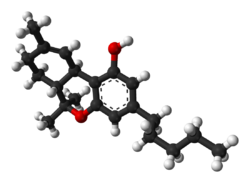Tetrahydrocannabinol (THC) is a cannabinoid found in cannabis. It is the principal psychoactive constituent of Cannabis and one of at least 113 total cannabinoids identified on the plant. Although the chemical formula for THC (C21H30O2) describes multiple isomers, the term THC usually refers to the delta-9-THC isomer with chemical name (−)-trans-Δ9-tetrahydrocannabinol. It is a colorless oil.
 | |
 | |
| Clinical data | |
|---|---|
| Trade names | Marinol, Syndros |
| Other names | (6aR,10aR)-delta-9-Tetrahydrocannabinol; (−)-trans-Δ9-tetrahydrocannabinol |
| License data |
|
| Dependence liability | Physical: Low Psychological: Low–moderate |
| Addiction liability | Relatively low: 9%[citation needed] |
| Routes of administration | By mouth, transdermal, sublingual, inhalation |
| Drug class | Cannabinoid |
| ATC code | |
| Legal status | |
| Legal status |
|
| Pharmacokinetic data | |
| Bioavailability |
|
| Protein binding | 97–99% |
| Metabolism | Mostly hepatic by CYP2C |
| Elimination half-life | 1.6–59 h, 25–36 h (orally administered dronabinol) |
| Excretion |
|
| Identifiers | |
| |
| CAS Number | |
| PubChem CID | |
| IUPHAR/BPS | |
| DrugBank | |
| ChemSpider | |
| UNII | |
| KEGG | |
| ChEBI | |
| ChEMBL | |
| CompTox Dashboard (EPA) | |
| ECHA InfoCard | 100.153.676 |
| Chemical and physical data | |
| Formula | C21H30O2 |
| Molar mass | 314.469 g·mol−1 |
| 3D model (JSmol) | |
| Specific rotation | −152° (ethanol) |
| Boiling point | 155–157 °C (311–315 °F) 0.05mmHg, 157–160°C @ 0.05mmHg |
| Solubility in water | 0.0028 mg/mL (23 °C) |
| |
| |
| | |
THC, also known pharmaceutically as dronabinol, is used medically to relieve chemotherapy-induced nausea, HIV/AIDS-related anorexia, and symptoms of multiple sclerosis, including neuropathic pain and spasticity. It acts as a partial agonist at CB1 and CB2 cannabinoid receptors.
THC can be administered orally, inhaled, or transdermally, with bioavailability and onset varying by route, and is extensively metabolized in the liver to active and inactive metabolites before being excreted in feces and urine. Side effects include red eyes, dry mouth, drowsiness, memory impairment, anxiety, and, with chronic use, cannabinoid hyperemesis syndrome. While human overdose is rare, THC can interact with other drugs and has a complex pharmacokinetic profile.
THC is classified variably under international and U.S. law, with medical use approved in multiple countries. Research supports its effectiveness for spasticity, central pain, and some multiple sclerosis symptoms, though evidence for other neurological disorders is limited, and long-term high-dose exposure may carry uncertain toxicity risks.
English
Etymology
From tetrahydro + cannabinol.
Pronunciation
- (Received Pronunciation) IPA(key): /ˌtɛ.tɹəˌhʌɪ.dɹə(ʊ)ˈkæn.əb.ɪn.ɒl/, /ˌtɛ.tɹəˌhʌɪ.dɹə(ʊ).kəˈnæb.ɪn.ɒl/
- (General American) IPA(key): /ˌtɛ.tɹəˌhaɪ.dɹək.əˈnæb.əˌnɔl/, /ˌtɛ.tɹəˌhaɪ.dɹoʊˈkæ.nə.bɪˌnɔl/
Noun
tetrahydrocannabinol (countable and uncountable, plural tetrahydrocannabinols)
- (organic chemistry) The psychoactive substance present in cannabis, a hydrogenated derivative of cannabinol.





